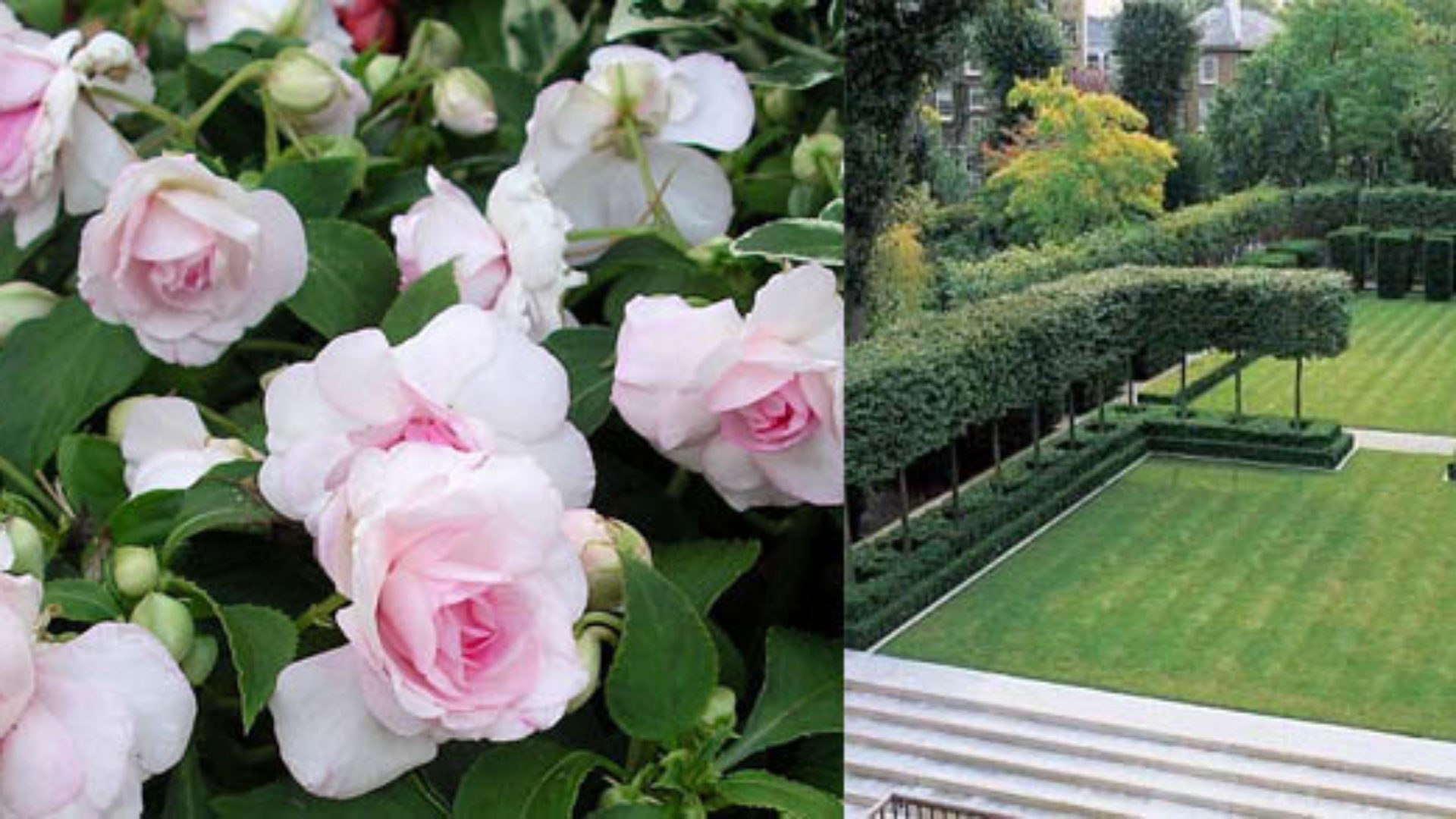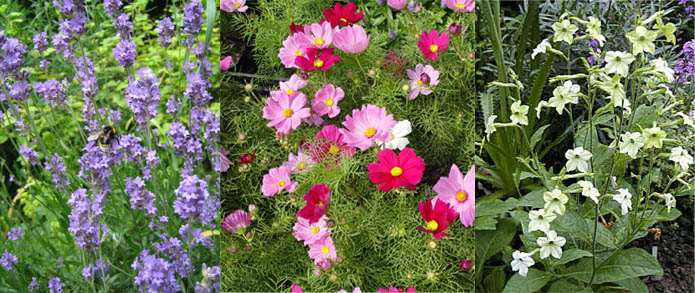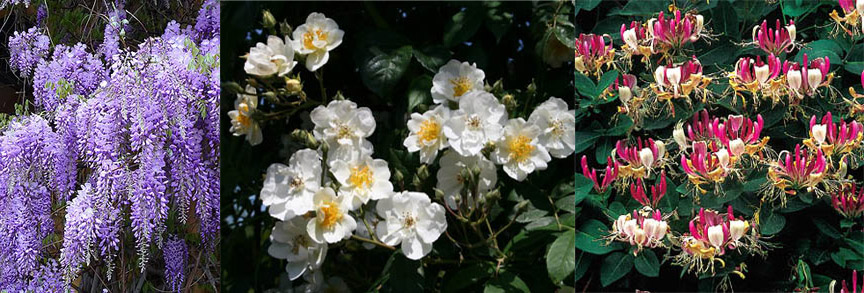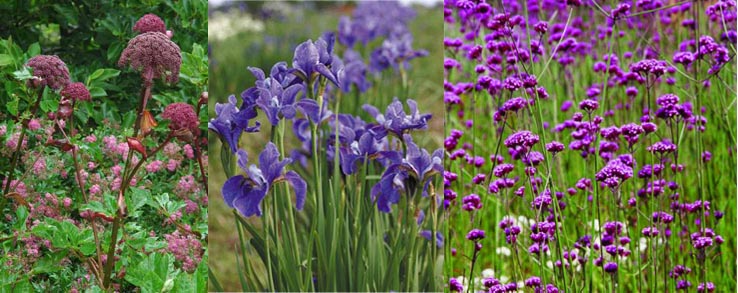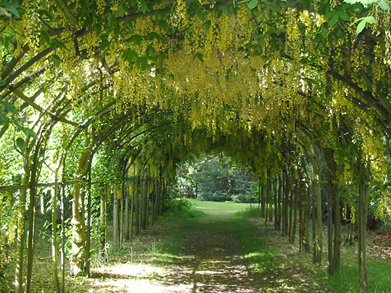This spring it seems Britain is a-buzz about bees … many of us have suddenly woken up to the fact that bees are more than just our honey-slaves, and that if we don’t look after our pollinating insects, our food production system could be in serious trouble. If this sounds melodramatic then stop to consider that in the UK alone, pollination is calculated to be worth about £430m to the national economy – food for thought!
Paradoxically it is modern farming practices that have swept away so much of the natural foraging grounds for our bees. Bees feed on pollen and nectar which they collect from flowers, and there are simply far fewer flowers in the countryside these days. Hedges have been removed, marshes drained and over 97% of flower-rich meadows have been lost from the UK. Add to that new research from France suggesting that common pesticides damage bees’ ability to navigate and dramatically reduce the numbers of queens they produce, and it’s little wonder bees are struggling!
Gardens are just about the only place left to them and even they are becoming unwelcoming: the fashion for sleek lawns, monoculture planting and everything clipped to within an inch of its life does not make for an attractive world to pollinators. They need flowers – but not just any flowers – sadly most annual bedding plants (eg Pelargoniums, Begonias, Busy Lizzies) have no nectar in them – you might as well be planting artificial flowers for all the use they are to bees.
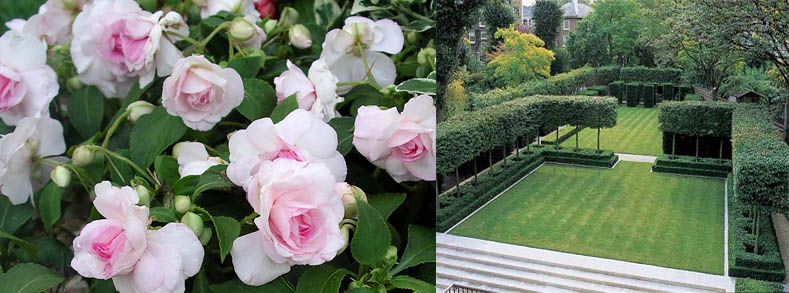
Gardens need to be designed for pollinators. The garden on the right has no flowers at all. The flowers on the left are double busy-lizzies, which may look nice but produce virtually no pollen or nectar so are useless to pollinators.
So, aside from campaigning to change the way Britain is farmed (good luck with that one!), how can we help the nation’s pollinating insects? Well there’s hope for bees in even the smallest garden:
Instead of filling your pots and windowboxes with bedding, why not plant flowering perennials or shrubs instead – lavender is the classic bee plant and there are many different types, but also think about catmint, lilies, sedums, hebes and heathers. If you’re absolutely wedded to bedding try wallflowers, sweet peas, cosmos, heliotrope or nicotiana – bees love them.
Herbs can be great for pollinators too: rosemary, fennel, hyssop, mint, oregano and sage are all nectar-rich and no kitchen doorstep should be without them. You could even plant up the joints between paving slabs with herbs and flowers – like thyme, thrift or erigeron daisies.
But if space is really at a premium think vertically: climbers are great way to add nectar – and texture – to a small space: favourite plants for pollinators include wisteria, honeysuckle, open-flowered roses, climbing hydrangea or if you’ve got room, wall shrubs like Ceanothus, Cytisus battenderii (the pineapple broom) or any of the Buddleias.
For the medium-sized garden, why not create an area for cottage garden flowers? A sunny border filled with achillea, campanula, hollyhocks, delphiniums, penstemons and asters will be buzzing with insect life; or for shadier areas plant lungwort, bugle, foxgloves and astrantia. If you have gaps in existing borders, why not fill them with easy annuals like cosmos, cornflowers, love-in-a-mist, eschscholzia or calendula – there are some great colour coordinated bee-friendly seed mixes about. Or go wild and sow some native wildflowers: bistort, verbascum, teasel and viper’s bugloss – a brilliant bee plant.
But the mayhem of the cottage garden isn’t for everyone. If you like your planting strong and structural, you can still benefit bees by using statuesque plants like angelica, cardoon, globe thistle or drifts of iris, alliums, and the ever-popular but wonderful Verbena bonariensis.
For the larger garden there are several different ways you can improve your bee-friendliness, from tree or hedge planting to meadow creation (a subject so complex it merits a blog of its own).
Fruit tree blossom is very attractive to bees, so creating an orchard or forest garden (the more natural equivalent) would be a great idea if you have the space. If that’s not possible, why not plant a crab apple, cherry or Judas tree and enjoy it for the blossom alone. And, while people tend to either love ’em or loath ’em, bees adore laburnums, so if you’re that way inclined, a laburnum arch would be a pollinator’s dream. And for the yellow-phobes among us, wisteria is a more restrained alternative.
Hedgerows are great places for all sorts of wildlife, but they can be a really important food resource for pollinators especially if wildflowers are encouraged to grow up along the base. They also provide good nesting sites for bumblebees. If you’re planning on planting a new hedge, think mixed and native: the hedgerow blossom of hawthorn, blackthorn, wild plum, dog rose, and honeysuckle are all well-loved by pollinating insects – throw in wildflowers like ox eye daisy, knapweed, red clover, scabious, sanfoin and viper’s bugloss at the base and you have a year-round supply of nectar.
Which brings me to a few important considerations: bees, butterflies and other beneficial insects need a regular supply of nectar all year round, so it’s important to plan your planting so you have several plants flowering at any given time right across the year. Pollinating insects come in all shapes and sizes, and different shaped flowers suit different species so mix it up floristically-speaking. And as a general rule of thumb, it’s best to avoid plants with double flowers – they keep their nectar hidden away making harder for bees to get at.
Any good garden designer will be bearing all this in mind anyway: providing seasonal interest for their client and ensuring that sustainable, environmentally-friendly options are given full consideration. If you feel inspired to take on transforming your patch into a pollinators’ paradise, there is plenty of information on the following websites – enjoy!
http://www.rhs.org.uk/Gardening/Sustainable-gardening/Plants-for-pollinators
www.bumblebeeconservation.org.uk/gardening_for_bumblebees.htm
www.plantforwildlife.ccw.gov.uk
One final thought – if you are keen to attract and encourage pollinators, but can’t completely kick the pesticide habit, then please check the ingredients of the products you use very carefully and keep your eye on the news. Several commonly used chemicals: Imidacloprid, Acetamiprid, Thiacloprid and Thiamethoxam, have already been potentially implicated in bee decline, and I doubt they’ll be the last…
Vicky Wyer

